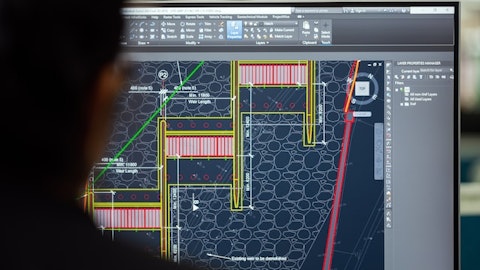And obviously, it’s going to be available 24/7. So that’s the first area. The second thing that we announced last week is this new generation of products called the AI plus products. And those are building on the AI capabilities that we have available today. So these are new products that will be packaged and priced accordingly. And these new AI plus products include things like ANSYS Granta, AI plus, optiSLang AI plus. And these new products will incorporate and extend some of the AI features that we already have within these products. The SimAI technology that we talked about, this is a brand new offering that is a cloud. It’s a cloud native AI platform that will augment our 3D physics simulation capabilities. And it’s essentially one where our customers will be able to do things like design analysis optimization by using simulation results to train an AI model to predict new design configurations using deep learning techniques.
And so this can predict performance across design changes, geometry changes, and so forth. It’s really a physics neutral technology. It applies across industry segments. And we can leverage simulation data whether it originates from ANSYS or from anyone else for that matter. So this is a – this is again, a new product that will be priced accordingly. The actual pricing has not been announced yet.
Mike Richards: Thank you.
Kelsey DeBriyn: Operator, we have time for one more question.
Operator: Our last question comes from Tyler Radke with Citi. Please go ahead.
Tyler Radke: Yes. Thanks for taking the question. Just wanted to follow up on the international performance. Looked like Germany in particular was a bit weaker. It sounds like you are seeing pretty resilient trends in autos. But wasn’t sure if that was a tougher compare or just anything to call out in Europe.
Nicole Anasenes: Sure. So, as just one reminder on the overall revenue results that you see in the results, we saw a lot of impact from the 606 accounting change. And so I am going to – I’ll answer to your question specifically related to that. But also kind of try to give some broader context around ACV because as you recall, this quarter ACV and revenue are highly disconnected. And your Germany answer or your Germany question is actually a prime example of the lease accounting dynamics that played out creating that year-over-year headwind. So, just to use that as an example, in Q3 2022, Germany saw exceptionally robust revenue growth. The revenue growth in Germany was 102% at constant currency. Now, the growth last year was a function of both strong ACV growth, but also the underlying accounting associated with the nature of the mix of transactions in that quarter.
And so I think that just gives you kind of a microcosm in Germany being a relatively larger portion of Europe, that was a dynamic that affected overall revenue growth. But when you zoom out and although we don’t give – we don’t typically provide ACV by geography, but EMEA had good growth on ACV in Q3 and – which was really reflective of the region’s operational stability. And just to give some kind of color to the dynamics and the underlying industry performance there, high-tech, aerospace and defense, industrial equipment industries all were strong in EMEA. The quarter was highlighted by sales to a global semiconductor manufacturer and supplier. We also saw a multi-year deal with a research and development company in the A&D industry.
They provided more users within its growing simulation team to access our solutions. And then we also had a multi-year deal with the European pump manufacturer that added more global users, more products, more physics, and HPC capacity. So more computation. So the revenue results are really emblematic of the dynamics that we talked about and expected in August. But the underlying ACV performance in the region is quite strong.
Tyler Radke: Okay. That’s helpful. And just to follow up on the long-term…
Ajei Gopal: Yes. And just to…
Tyler Radke: Yes.
Ajei Gopal: Yes. Just to add to what Nicole was saying, I mean, I think that we would – when we talk about – when I talk about my own experiences with customers, sort of anecdotally as I said before, I have an opportunity to talk to customers and channel partners. And we’re really seeing strength, as Nicole said, across multiple industries and across also the different market segments. And in particular, when I talk to channel partners who focus more at the lower end, we’re seeing a lot of activity. And obviously, at our enterprise customers, where we directly engage, we’re seeing a lot of activity. So there’s a lot of design work and R&D efforts that are taking place across these industries across the world. And we believe – and we’re excited about our ability to support our customers in those spaces.
Tyler Radke: That’s helpful. And…
Nicole Anasenes: Tyler, you had a follow-up question.
Tyler Radke: Yes, I did. I did. So just as I think about the 2024 comments and your helpful breakout of the China impacts in terms of I think, two thirds being just delayed business, should we think about that all happening in 2024? And then as I think about your reiteration of your long-term targets, I guess if you could just kind of unpack the puts and takes and do you assume to kind of have the China business normalize and get that full two thirds through the long-term targets? Thank you.
Nicole Anasenes: Yes. Yes. I mean, I’d say that when you look underneath, so, as we said, we expect to initiate in 2024 – in February, in 2024 on the model. So 10% constant currency growth, excluding tuck-in M&A. Now, the impact of what we’re estimating to be dropout that we are kind of overcoming in that underlying model is the $10 million to $30 million of ACV in revenue. Now, throughout the year, there’s some shift in timing from this year to next year and next year to the year after. But kind of that just is like the permanent shift that we would expect underneath the covers. But in terms of the kind of – the pure headwind, which is that we’d be wrapping on coming out of 2024, it would be that $10 million to $30 million.
Tyler Radke: Okay. Thank you.
Kelsey DeBriyn: That’s all the time we have today. I will turn it over to Ajei for some closing remarks.
Ajei Gopal: Thank you, Kelsey. With our market leading product portfolio and strong pipeline, ANSYS is well positioned to meet our commitments. I want to thank my colleagues around the world for their continued dedication to ANSYS. I want to thank our channel partners, and I want to thank, of course, our global customer base. Thank you your time today, and have a great day.
Operator: The conference has now concluded. Thank you for attending today’s presentation. You may now disconnect.
Follow Ansys Inc (NASDAQ:ANSS)
Follow Ansys Inc (NASDAQ:ANSS)
Receive real-time insider trading and news alerts




